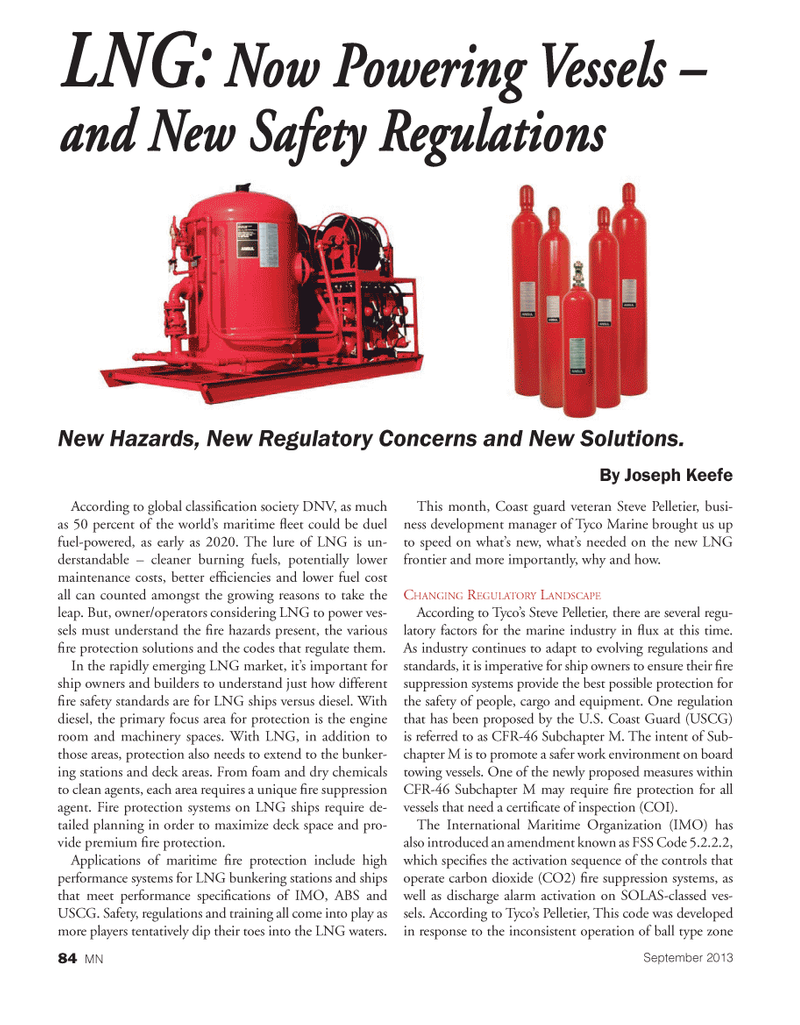
Page 84: of Marine News Magazine (September 2013)
Workboat Annual
Read this page in Pdf, Flash or Html5 edition of September 2013 Marine News Magazine
According to global classi? cation society DNV, as much as 50 percent of the worlds maritime ? eet could be duel fuel-powered, as early as 2020. The lure of LNG is un- derstandable ? cleaner burning fuels, potentially lower maintenance costs, better ef? ciencies and lower fuel cost all can counted amongst the growing reasons to take the leap. But, owner/operators considering LNG to power ves- sels must understand the ? re hazards present, the various ? re protection solutions and the codes that regulate them. In the rapidly emerging LNG market, its important for ship owners and builders to understand just how different ? re safety standards are for LNG ships versus diesel. With diesel, the primary focus area for protection is the engine room and machinery spaces. With LNG, in addition to those areas, protection also needs to extend to the bunker- ing stations and deck areas. From foam and dry chemicals to clean agents, each area requires a unique ? re suppression agent. Fire protection systems on LNG ships require de- tailed planning in order to maximize deck space and pro- vide premium ? re protection. Applications of maritime ? re protection include high performance systems for LNG bunkering stations and ships that meet performance speci? cations of IMO, ABS and USCG. Safety, regulations and training all come into play as more players tentatively dip their toes into the LNG waters. This month, Coast guard veteran Steve Pelletier, busi- ness development manager of Tyco Marine brought us up to speed on whats new, whats needed on the new LNG frontier and more importantly, why and how. CHANGING REGULATORY LANDSCAPE According to Tycos Steve Pelletier, there are several regu- latory factors for the marine industry in ? ux at this time. As industry continues to adapt to evolving regulations and standards, it is imperative for ship owners to ensure their ? re suppression systems provide the best possible protection for the safety of people, cargo and equipment. One regulation that has been proposed by the U.S. Coast Guard (USCG) is referred to as CFR-46 Subchapter M. The intent of Sub- chapter M is to promote a safer work environment on board towing vessels. One of the newly proposed measures within CFR-46 Subchapter M may require ? re protection for all vessels that need a certi? cate of inspection (COI). The International Maritime Organization (IMO) has also introduced an amendment known as FSS Code 5.2.2.2, which speci? es the activation sequence of the controls that operate carbon dioxide (CO2) ? re suppression systems, as well as discharge alarm activation on SOLAS-classed ves- sels. According to Tycos Pelletier, This code was developed in response to the inconsistent operation of ball type zone New Hazards, New Regulatory Concerns and New Solutions. By Joseph Keefe LNG: Now Powering Vessels ? and New Safety Regulations September 201384 MNMN Sept2013 Layout 82-95.indd 848/30/2013 10:57:07 AM

 83
83

 85
85
